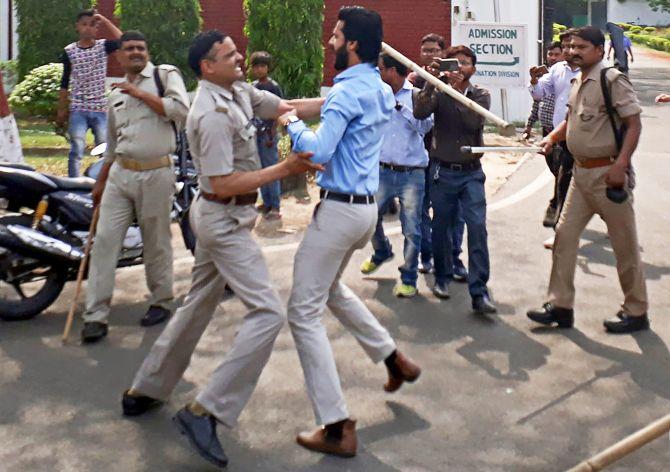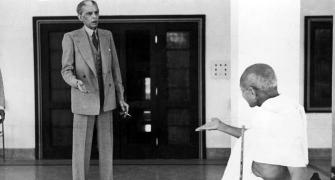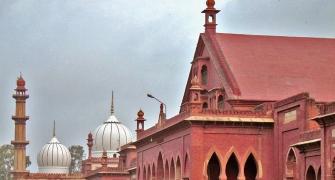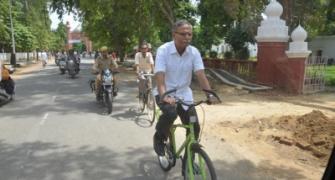'Besides electoral opportunism, a sustained vilification of AMU on one or the other pretext helps them sustain their 'everyday communalism', the new strategy of the BJP of the Narendra Damodardas Modi-Amit Anilchandra Shah era,' says Mohammad Sajjad.

A series of onslaught by the incumbent regime against some of the best universities of India has sort of become the order of the day.
Other thinkers, activists, writers are sought to be demonised and victimised.
Violent zealots have resorted to killing such thinkers following a definite discernible pattern that suggests these forces get support from majoritarian outfits.
The State and compromised television news channels have been popularising a phrase: 'Urban Naxals', meaning disloyal, unpatriotic, and subversive. Those suspected to be Urban Naxals are subject to severe police harassment.
A social common sense is being manufactured to justify the brutal persecution of such people. And the subjugated and marginalised identities such as Dalits and Muslims are the obvious targets of majoritarian bigotry.
This is in addition to the forced displacement of tribes where the State aides corporates in occupying the land, forest,and mineral resources while taking away the traditional rights of poor, hapless, tribes.
Authoritarian and totalitarian regimes across the world have been doing so in modern times. With the neoliberal economy, a rightward shift in polities is to be found in many countries today.
Thus, Recep Tayyip Erdoğan in Turkey has thrown many students and academics into prison. In India, prestigious universities like JNU and Hyderabad became targets.
The Aligarh Muslim University is, of course, continuously their target.
Besides its 'Muslim' identity, a certain kind of history has also been popularised and perpetuated about this historic institution since the late 19th century, and also about India's Partition since 1947, which breeds anti-Muslim and anti-AMU hatred.
Nineteenth century India being a British colony was in an era of particular-ism based on religion, caste, etc. The socio-religious reform movements were confined within respective identities.
The Brahmo Samaj of Raja Ram Mohan Roy was confined essentially within urban bhadralok Bengalis.
The Arya Samaj was based among certain social groups of specific parts of India. There were numerous caste-based associations in the late 19th and early 20th centuries.
Many educational movements and institutions emerged accordingly. The Hindu (later, Presidency) College of Calcutta, a chain of DAV schools and colleges, BHU, etc, all came out of it.
So was the case with the MAO College of Aligarh, founded in 1877, which became the Aligarh Muslim University in 1920. Yet, quite selectively, only the founder of the MAO College is projected as an exclusionary figure.
The Aligarh Movement became a metaphor of modernity among the Muslims of the subcontinent, notwithstanding its definite limitations on the questions of caste and gender.
Its founder, Sir Syed Ahmad, passed away in 1898. India came to be divided almost half a century later in 1947.
Yet, liberal as well as majoritarian reactionary forces trace the idea of the two nation theory to Sir Syed. He has thus been made a villain in certain narratives and in historiographies.
This motivated blame-game came to be reinforced with the argument that the Muslim League was a strong force at AMU during 1938-1947.
That within the AMU campus, just as in the rest oe society, all political-ideological trends competed with each other, is also chosen to be ignored.
The historical facts of Bhai Parmanand (1901), Lala Lajpat Rai (in 1923), and Vinayak Damodar Savarkar (in 1923 and 1938) having propounded such divisive proposals and theories are chosen to be downplayed/ignored.
Even liberal historians tried to put almost all the blame for India's Partition solely on the Muslim League; and the suffix 'League' was chosen to be forgotten, thereby vilifying the entire community of Muslims as the villains of Partition.
That State power was with the British who played a predominant role in dividing India is chosen to be downplayed; that the majoritarian, exclusionary forces within the lower Congress and the Hindu Mahasabha-RSS kind of forces alienated the Muslims upon which the League played its own politics, is also conveniently ignored.
That a fairly good proportion of common Muslims resisted the two-nation theory, and that they upheld the principles of composite and united nationalism (muttahidah qaumiyat and mushtareka wataniyat), is conveniently chosen to be forgotten.
This is how India's Muslims came to be demonised as traitors.
Matters are made more woeful for India's Muslims by Pakistani historiography. In order to give antiquity to their 'nationalism', they also identify Sir Syed to be the earliest proponent of their brand of exclusionary and divisive 'nationalism'. Thus, the sub-continental majoritarianisms reinforce each other's partisan and blinkered historiographies and nationalisms.
Since the Muslims of the subcontinent identify their tryst with modern education with Sir Syed, regardless of their direct association with AMU, the patently unjustified blame of Partition is put almost solely at the door of the entire community of Muslims. Hence, a perpetual suspect!
Having manufactured this kind of 'Hindu common sense', the AMU becomes a soft, easy and convenient target for the politics of majoritarian consolidation.
Besides electoral opportunism, a sustained vilification of AMU on one or the other pretext helps them sustain their 'everyday communalism', the new strategy of the BJP of the Narendra Damodardas Modi-Amit Anilchandra Shah era.
It helps them to perpetuate and sustain the vilification of Muslims in 'Hindu' minds.
Suppose, just for a moment and for the sake of argument, that the politics of blaming AMU of pre-1947 is historically valid, then what is the justification for holding the current generation to be accountable for it?
Why should historical revenge be acceptable? But the sad point is, who cares for nuanced arguments!
Such is the force of majoritarianism that Presidency College never felt compelled to be apologetic about its Hindu-only hostel; a DAV College is not held accountable for gross under-representation of Muslims in its enrolments; BHU is not asked why it does not have a masjid in its premises.
But AMU is issued an ultimatum by a local BJP politician to construct a temple inside its premises, within a fortnight.
BHU never feels compelled to explain certain things about its founder Madan Mohan Malaviya (1866-1946), but AMU's founder is held 'culpable' on certain counts.
That Sir Syed did a lot towards inclusion of Hindus in his institution and wrote too many editorials in his Aligarh Institute Gazette to this effect, remains almost unheard, despite the 'defensive and apologetic' Muslims repeating it ad nauseum, just to reinforce their pluralist and patriotic credentials.
This explains why targeting AMU, and by implication India's Muslims, helps majoritarian forces.
There is another reason too -- ghettoisation of education.
Various government reports, NSSO data and other such credible survey reports testify to the exclusion of Muslims in higher education. Not more than 4% of them are in higher education (external link) despite institutions like AMU, Jamia Milia, Maulana Azad National Urdu University, etc.
If contributions of these 'minority' institutions in creating a modicum of middle class among Muslims are discounted, then the data will become more dismal. Hence, further shame for Indian democracy over the terms of inclusion.
Some ill-informed people carry the notion that Muslims prioritise madrasa education. They need to be told that only 4% of literate-educated Muslims go to madrasas.
These 4% are at the lowest rung of economy and education, who get free food and lodging in the community-funded madrasas.
The rest 96% of the educated Muslims obtains modern education.
It is therefore, high time that India's Muslim-hating segments of Hindus realised the role that institutions like AMU have played and continue to play in producing educated middle classes and professionals -- doctors, engineers, lawyers, managers, journalists, political leadership, teachers, researchers, and the like.
They play their own role in making Muslims realise that India's pluralistic democracy has made all arrangements for the inclusion of its minorities which re-assures them about India's plurality and secularism.
It helps in checking alienation of the minorities. These segments fight conservatism and communalism within the community, thereby strengthening Indian democracy, in a significant way.
Or is it the case that an increasingly communalised strata of the majority wants to see Muslims only as subjugated and muted, rather than as equal citizens with proportionate share in structures and processes of power?
The Muslim communities of southern and western India have erected quality educational institutions through their educational trusts and community-based fund mobilisations.
The Muslim communities of northern and eastern India lag badly behind.
Even the Majlis-e-Ittehad-ul-Muslimin of Hyderabad expanded its base by intervening in and taking initiatives in the domain of modern education. So it is intriguing that even this party, while trying hard to get electoral-political foothold in certain parts of Uttar Pradesh and Bihar, is not replicating its own model. This party is not contemplating opening such quality educational institutions in these parts of UP and Bihar.
While the scheduled castes and sxheduled tribes have improved their educational status, compared to the Muslims, through protective discriminations, the inclusion of subjugated castes of Muslims in the list of Other Backward Classes has helped only marginally.
Not all well-off Muslims prefer institutions like AMU. Many children of accomplished AMU alumni do not prefer the university anymore now. Other segments of Muslims prefer AMU for economic and cultural reasons. AMU also provides much economical lodging and food compared to other premier institutions.
Moreover, the public-funded educational institutions in district towns and provincial capital cities have sort of collapsed across northern and eastern India. They have therefore rushed to AMU.
Average Muslim middle class persons feel culturally secure about their girls inside AMU. Students from UP, Bihar, and recently Kashmir, and northern districts of West Bengal, besides some from the north east, are the regional profiles of AMU students and teachers.
Thus, 'educational ghettoisation' of Muslims is needed to be understood with objectivity and without malice.
The above two factors (Partition historiography blaming Muslims, and ghettoisation) make Muslims react in a certain way as and when there is a vilifying onslaught against AMU by the majoritarian forces, aided by sections of the media, which often spreads blatant falsehoods.
This onslaught and the Muslim response thereof, help majoritarian consolidation.
This puts AMU a little apart from the other targeted universities like Hyderabad and JNU.
It needs to be realised that the Muslim segment of Indian democracy needs certain kind of arrangements for its educational uplift and overall empowerment.
One cannot be sure if the ascendant majoritarianism is a short-lived phenomenon or if it will really recede to give way to a better India.
That is the moot question staring all those faces who look forward to a better, empowered, resurgent India, with its inclusionary, pluralist, civilisational character.
Mohammad Sajjad is Professor of History, Aligarh Muslim University.









